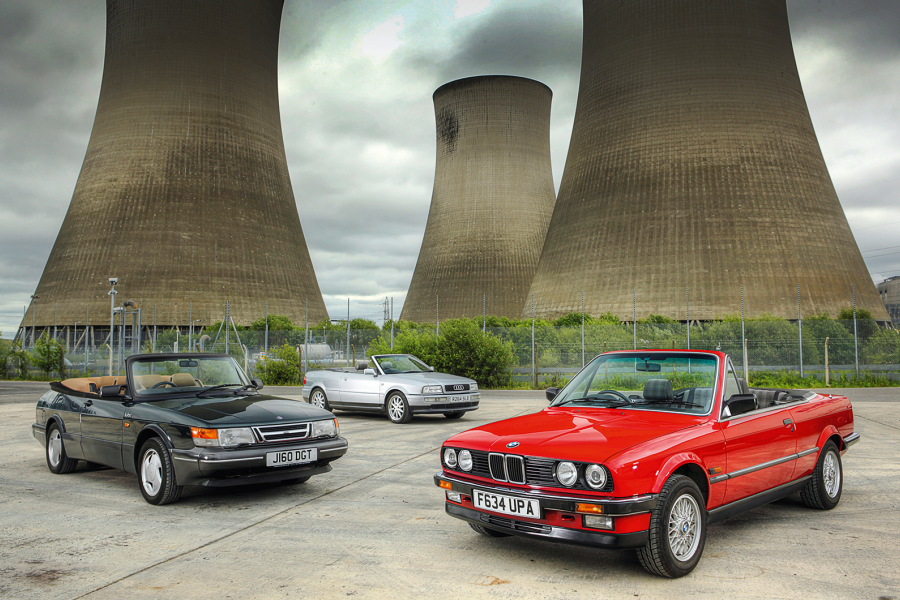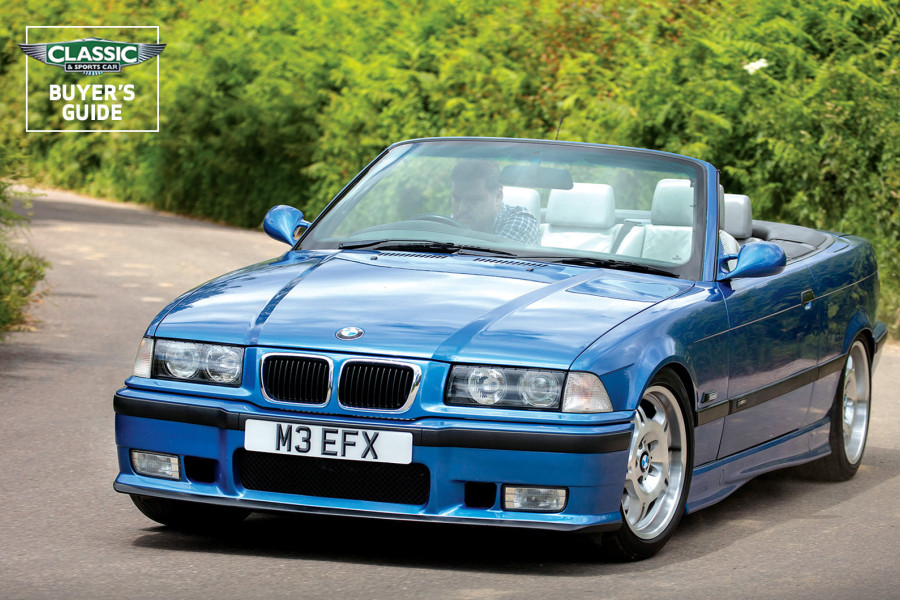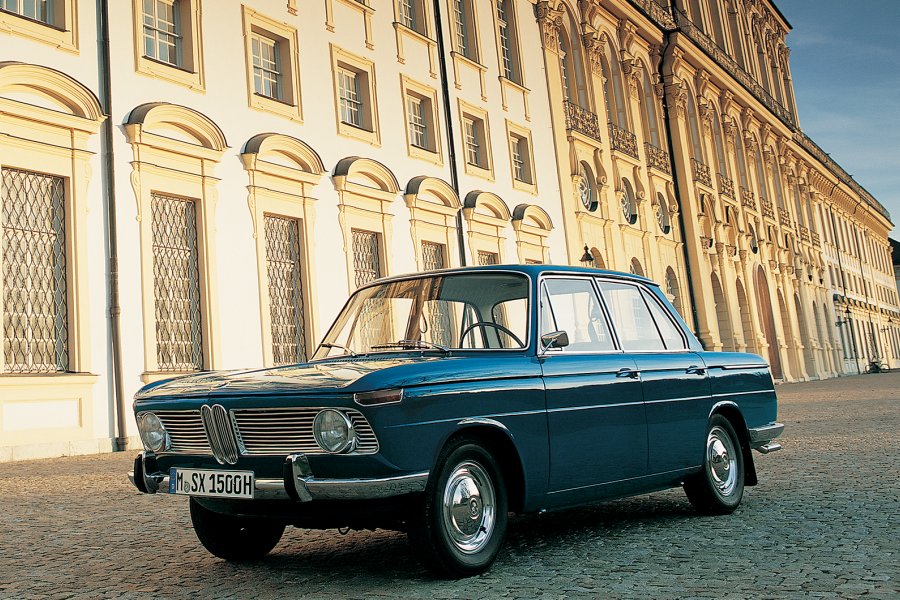Engineers added a further 44cc to make a 3245cc unit that, mated to everything that late-’90s BMW could throw at it, is now considered one of the marque’s finest.
Boasting the latest twin VANOS and an in-house, industry-leading engine management system that even controlled the individual throttle bodies, this was a 343bhp, 269lb ft masterpiece.
Suede adorns the M3 CSL’s steering wheel, seats and handbrake lever
Likewise the chassis, and enthusiasts felt their calls had been answered.
Except that there was one last brushstroke to come: the CSL.
It was a bold move to revive the name of one of its most famous cars, the 1973 3.0 CSL, for a model that hadn’t any specific competition purpose, but building on the commercial success of the M3, BMW directed the final efforts of the Motorsport department to achieve the E46 M3’s nth degree.
It paid off almost immediately.
Off the back of the superb standard car, the M3 CSL rushed to the top of enthusiasts’ collective consciousness and into marque history books with the sort of assurance sadly alien to any E36.
Bulging arches signify the BMW M3 CSL’s wider track
BMW promised to make 1000, at £58,445 each – nearly £20k more than a standard M3 – and ended up fulfilling orders for 1383 cars.
Hunkered down and bulging with track-ready muscle, the CSL brings the Sport Evo’s visual presence to the E46.
Its wider tracks, bigger 19in wheels and bespoke aero kit don’t quite mimic the E30 – the arches bulge from the wings rather than blending into the body, and the splitters, spoilers and intakes more accurately direct the airflow – but the overall effect is evocative.
Inside, it feels just as purposeful with suede seats, steering wheel and handbrake, plus glossy carbonfibre detail on the doors and centre console.
The rest is black and grey, and the CSL feels more austere and less richly finished than the E36 GT.
The carbonfibre intake manifold dominates the BMW M3 CSL’s engine bay
You forget about the interior quite quickly, however.
The ‘six’ fires into life with a bark and the SMG automated manual clunks into gear with race-car attitude.
There’s a slight coarseness to the exhaust note as the car warms, and the ride is just the wrong side of forgiving over a rough B-road.
But as the oil temperature climbs and the rev-counter warning lights fade away, a flex of the throttle ignites the CSL’s spectacular character.
Piling on the revs elicits a growl from ahead and a shove from the seatback as the 265mm-wide Michelin Pilot Sports grab the road surface.
The more focused M3 GTS (left) sits lower than the CSL, but it’s a more challenging car to drive fast
You feel their tenacious hold through beautifully weighted steering, giving complete confidence to remain committed as the engine’s tone shifts to an epic, full-bore howl above 6000rpm that carries, probably for miles, to a heady 8000rpm limit.
The snappy gearshifts benefit from a brief lift, and prodigious braking successfully brings you back to earth, but just like the E30, it’s a car that feels natural to drive fast.
Why don’t other E46 M3s feel like this? It turns out that nth degree took some finding.
No less than 95kg was shaved off the kerbweight: 7kg thanks to the famous carbonfibre roof, with other savings in the carbonfibre doors, an aluminium honeycomb boot floor, a composite rear bulkhead, thinner rear glass, and the loss of the radio, air-conditioning and electric seats (although all were available as options).
The suspension was thoroughly reworked, including more aggressive geometry and bespoke aluminium rear control arms, while a sharper 14.5:1 ratio steering rack replaced the existing 15.4:1 item.
Both of the later cars feature distinctive aero tweaks, the CSL (right) with a ‘ducktail’ spoiler and the GTS with a rear wing
Power was edged up by 17bhp and torque by 4lb ft thanks to hotter cams and lots of work on the intake and exhaust systems, including a carbonfibre intake manifold.
There had been plans for a V8-powered E46 M3, and even a short-lived, non-homologated GTR that took advantage, then became a victim, of the American Le Mans Series regulations of 2001 and 2002 respectively.
But it was the subsequent E92 3 Series that finally brought an eight-cylinder M3 to market in 2007.
The S65 engine was itself a derivative of the V10 seen in the M5 three years earlier, and was 15kg lighter than its predecessor’s ‘six’ thanks to finally adopting all-aluminium construction.
It would eventually form the basis of a variety of racers, notably BMW’s 2010 Z4 GT3.
The M3 GTS has deep bucket seats in the sparsely trimmed cabin
Wide and powerful styling came as standard on the GTS, so too did a carbonfibre roof – proving how seminal the E46 CSL had been in a market with an eye for racy detailing.
The Motorsport division was by then fully established as a brand, with commercial importance and a well-defined identity outside of competition.
So it was no surprise that the extreme GTS was marketed as the ultimate track-day M3 rather than a nod to the World Touring Car Championship cars from which it sourced its aerodynamic bodykit and wing.
That made sense: those racers had been based on 320is specification since the E36, while buyers of the GTS could look forward to much more.
The already mighty S65 V8 was pumped up by 36bhp and 30lb ft, to 450 and 325 respectively, and bellowed through a new exhaust system with titanium silencers.
The BMW M3 GTS makes for a rare sight on the road, with just 135 built
The suspension was lower, the rear subframe rigidly mounted, and the bigger brakes had six-piston calipers up front.
Inside, the deep, lightweight bucket seats and rollcage were hard to miss, but the large strip of carbonfibre trim and bare centre console looked at odds with a dashboard clearly intended for the generous switchgear of a late-2000s BMW.
The GTS is a huge wallop of M3, perhaps too much for regular road use.
It fidgets and squirms on its firm suspension, while the throttle and steering feel hyperactive.
The rollcage rear braces were an optional extra for the BMW M3 GTS
Find a road that makes the most of the GTS set-up, however, and the engine explodes into action, the chassis offers astonishing grip, and the dual-clutch gearbox delivers its changes in satisfying snaps.
The V8 is quieter than you expect, but its resonating roar at the top end is addictive.
In full attack mode the GTS is special, but it belongs on a track.
That all 135 sold almost immediately upon release in 2010, adding to a total of 200,000 M3s since 1986, says something about the model’s impact.
The 4361cc V8 engine in the M3 GTS produces 450bhp
Today, the E30 M3 offers a particularly authentic taste of the Motorsport division, and the Sport Evo delivers everything you’d expect from the peak of its breed.
It feels special in a way the others here can’t quite match… except perhaps the E46.
While the GT and GTS clearly speak to their times, the CSL manages to channel its inner racer and amplifies it for the thrill of its roadgoing owners.
That, and surely one of the greatest engines ever made, is why it’s the one I’d like one more drive in.
Images: John Bradshaw
Thanks to: the owners, and BMW Car Club GB
Factfiles
BMW M3 Sport Evo (E30)
- Sold/number built 1989-’90/600
- Construction steel monocoque
- Engine iron-block, alloy-head, dohc 2467cc ‘four’, with Bosch Motronic fuel injection
- Max power 238bhp @ 7000rpm
- Max torque 177lb ft @ 4750rpm
- Transmission five-speed manual, RWD
- Suspension independent at front by MacPherson struts rear semi-trailing arms, coils, telescopic dampers; anti-roll bar f/r
- Steering power-assisted rack and pinion
- Brakes 11in (279mm) vented front, solid rear discs, with servo and anti-lock
- Length 14ft 3in (4345mm)
- Width 5ft 6in (1680mm)
- Height 4ft 6in (1370mm)
- Wheelbase 8ft 5in (2565mm)
- Weight 2646Ib (1200kg)
- 0-60mph 6.1 secs
- Top speed 154mph
- Mpg 25
- Price new £34,500 (1989)
- Price now £80-180,000*
BMW M3 GT (E36)
- Sold/number built 1994-’95/356
- Construction steel monocoque
- Engine iron-block, alloy-head, dohc 2990cc ‘six’, with Bosch Motronic 3.3 electronic fuel injection
- Max power 295bhp @ 7100rpm
- Max torque 238lb ft @ 3900rpm
- Transmission five-speed manual, RWD
- Suspension independent at front by MacPherson struts rear multi-link transverse and trailing ‘Z’ arms, coils, telescopic dampers; anti-roll bar f/r
- Steering variable-ratio power-assisted rack and pinion
- Brakes 12½in (315mm) vented front and 12¼in (312mm) solid rear discs, with servo and anti-lock
- Length 14ft 6½in (4433mm)
- Width 5ft 5¼in (1710mm)
- Height 4ft 5¾in (1366mm)
- Wheelbase 8ft 10¼in (2700mm)
- Weight 3153Ib (1430kg)
- 0-60mph 5.9 secs
- Top speed 171mph
- Mpg 24
- Price new 91,000DM (£36,400 before import charges, 1994)
- Price now £30-80,000*
BMW M3 CSL (E46)
- Sold/number built 2003-’04/1383
- Construction steel monocoque
- Engine iron-block, alloy-head, dohc 3245cc ‘six’, with BMW MSSS54 engine management and electronic fuel injection
- Max power 360bhp @ 7900rpm
- Max torque 272lb ft @ 4900rpm
- Transmission six-speed sequential automated manual, RWD
- Suspension independent, at front by MacPherson struts rear multi-link transverse and trailing ‘Z’ arms, coils, telescopic dampers, anti-roll bar f/r
- Steering power-assisted rack and pinion
- Brakes 13½in (340mm) front, 12¾in (325mm) rear vented discs, with
servo and anti-lock
- Length 14ft 8¾in (4492mm)
- Width 5ft 10in (1780mm)
- Height 4ft 5¾in (1365mm)
- Wheelbase 8ft 11½in (2729mm)
- Weight 3142Ib (1425kg)
- 0-60mph 4.8 secs
- Top speed 161mph
- Mpg 24
- Price new £58,455 (2003)
- Price now £60-100,000*
BMW M3 GTS (E92)
- Sold/number built 2010/135
- Construction steel monocoque
- Engine all-alloy, dohc-per-bank 4361cc V8, with Siemens MSS60 engine management and electronic fuel injection
- Max power 450bhp @ 8300rpm
- Max torque 325lb ft @ 3750rpm
- Transmission seven-speed dual-clutch automated manual, RWD
- Suspension independent at front by MacPherson struts rear multi-link transverse and trailing arms, coils, telescopic dampers; anti-roll bar f/r
- Steering power-assisted rack and pinion
- Brakes 14⅞in (378mm) front, 15in (381mm) rear vented discs, with servo and anti-lock
- Length 15ft 2¾in (4645mm)
- Width 5ft 11in (1804mm)
- Height 4ft 6½in (1387mm)
- Wheelbase 9ft ¾in (2760mm)
- Weight 3373Ib (1530kg)
- 0-60mph 4.4 secs
- Top speed 190mph
- Mpg 22
- Price new £115,215 (2010)
- Price now £120-180,000*
*Prices correct at date of original publication
READ MORE
50 years of BMW M cars
Buyer’s guide: BMW E46 M3
Daring to be different: Lotus Elan M100 vs BMW Z1
Aaron McKay
Aaron is Classic & Sports Car’s Deputy Editor



























